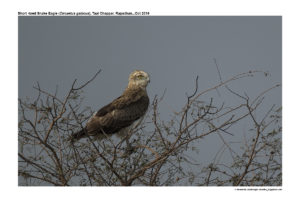Short-toed Snake Eagle

Short-toed Snake Eagle Circaetus gallicus
Etymology:
- Circaetus : Greek word kirkos – type of hawk, harrier; aetos – Eagle
- Gallicus : from Gallia – Gaul , Modern day France
Vernacular Names: Hindi:Saampmaar, Pun: Sappmarukab, Ben: Saapmaril, Guj: Saapmar, Wagri: Rawal, Ta: Onankoththi, Pambuparandu, Te: Pamulagadda, Yerkali: Kondatele, Kan: Malpatar, Mar: AkhudBotanchaSarpgarud
Distribution in India: Widespread Resident in India.
Description: Size of 62-67 cm; wt. of male is 1200–2000 g, wt. of female is 1300–2300 g; wingspan of 166–188 cm.It has long and broad wings, pinched at base and a long tail. It soars with wings flat or slightly raised. Has a habit of frequently hovering in midair. When perched the wing tips reach the tail ends and has a long unfeathered but scaly tarsus. It has variable plumages with Dark head and breast, barred underbody, dark trailing edges to underwings and broad sub-terminal tail band. The upper side is pale brown in all plumages, pale brown inner wing coverts that contrast with dark greater coverts and flight feathers. It has an orange-yellow iris. The juvenile is similar to adult, has a rufous tone to hood and underparts markings, pale tips to median and greater wing-coverts, and has throat paler than breast band.
Habitat:It is found in varied habitats mainly in warm temperate and tropical zones; from open woodland and even fairly dense forest to semi-desert. Often occurs in areas with mixed habitats: requires fairly open areas rich in reptiles.
Food Habits: It specializes in eating reptiles, particularly snakes, mainly non-venomous species. Also takes other reptiles, particularly lizards, including small monitors , chameleons, geckos, slow worms and skinks; occasionally mammals like rodents, shrews, rabbits, hares, hedgehogs and also amphibians and a few birds (including nestlings, but mainly sick or injured individuals). Forages at medium height with gliding or soaring flight; to survey terrain more closely, hovers on wind or with wings beating, parachuting down on prey, once located, often with a brief final hover. It is also known to still-hunt from prominent perch and even to stalk prey on ground. It swallows snakes and lizards whole, head first; but head may be crushed or torn off prior to consumption, and large snakes can be torn to pieces before being eaten; part of prey sometimes sticks out of bill, when bird already in flight. Smaller prey may be swallowed whole in flight.
Breeding Habits: They breed in Dec- Feb in India.They nest almost exclusively in trees, rarely very tall, often only a few meters in height; very rarely nests on cliff ledges; sometimes uses nest of other raptors or corvids. The nest is built on crown of tree or on topmost lateral branch, tree occasionally on small islands in lakes. The nest is built of sticks and twigs, and lined with green leaves or grass, occasionally even pine needles. New nest built each year. It lays a clutch of one egg . The incubation period is 45–47 days, mainly or entirely by female. The chick is born altricial and cared for and fed by both adults; at first given small bits of food, but later learns to pull prey out of adult’s crop, and swallow it whole. The fledging happens in 60–80 days. The chicks become independent, leaving parent’s territory soon after.